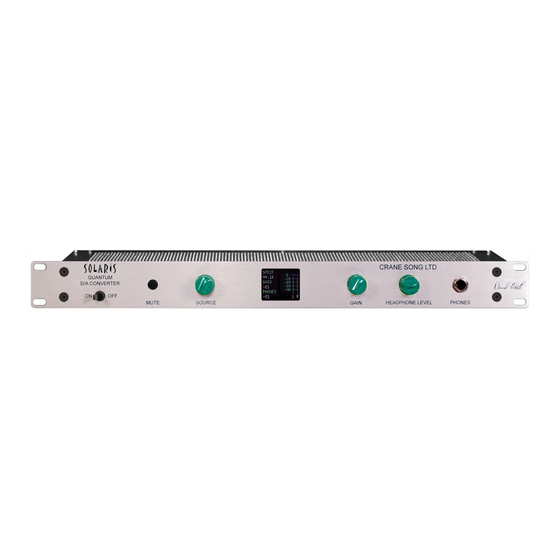
Subscribe to Our Youtube Channel
Summary of Contents for Crane Song SOLARIS Quantum DAC
- Page 1 Quantum DAC PERATOR'S ANUAL Version 1.2 20201103 LTD. 2117 East 5th Street Superior, WI 54880 USA tel: 715-398-3627 fax: 715-398-3279 www.cranesong.com © 2016, 2020 Crane Song, LTD. Subject to change without notice. Printed in the U.S.A.
- Page 2 Thank you and congratulations on your recent purchase of the Crane Song Solaris Quantum DAC. The Solaris Quantum DAC is a 2 channel Digital-to-Analog Converter, designed by Dave Hill. It is centred around a 32-bit converter and 32 bit ASRC (Asynchronous Sample Rate Converter) that up-samples to 211kHz in order to reduce jitter.
-
Page 3: Important Safety Instructions
IMPORTANT SAFETY INSTRUCTIONS 1. Read these instructions 2. Keep these instructions 3. Heed all warnings 4. Follow all instructions 5. Do not use this apparatus near water 6. Clean only with dry cloth 7. Install in accordance with the manufacturer's instructions 8. - Page 4 THE INs AND OUTs OF THE SOLARIS On the back of the DAC you’ll find the inputs and outputs. The input options are AES, S/PDIF, Optical and USB. The AES input connects over XLR, S/PDIF via RCA Phono, Optical goes in on Toslink. USB allows you to connect the Solaris directly to your computer and use it as a dual-channel/ stand-alone output only interface.
- Page 5 Just plug up via USB and you’ve got your Crane Song sound feeding your portable rig. You can take it a step further and feed the backing track mix to Front Of House and deliver the pristine Crane Song sound to be part of the live performance.
- Page 6 Solaris to convert them, process them and then record them back in through your A-D Converter, like the Crane Song HEDD. • That NY Compression Trick. You’ve probably heard of NY or parallel compression, where you take a parallel feed of your drums and maybe the bass, EQ and compress them together and then blend that signal back into the mix.
-
Page 7: The Front Panel
THE FRONT PANEL LCD Function Display MUTE On power on all outputs including the Headphones are muted After that the Headphones do not mute POWER SOURCE This selects the input AES, S/PDIF, OPTICAL, GAIN This is the main output level HEADPHONE LEVEL HEADPHONES... - Page 8 CONFIGURATION Built in Pad Scale type Muting Set up for the Solaris could not be easier. Plug up your in and outputs, power up and you're ready to go. When you power up the Solaris and hold down the MUTE button until the red SOLARIS name switches to full black screen, you'll engage the Setup Menu.
- Page 9 MUTE MODES UNMUTE PHONES Solaris will auto unmute and the MUTE button will mute both the main outputs and the phones UNMUTE NO PHONES Solaris will auto unmute and the MUTE button will mute the main outputs, the phones are not muted with the button MUTE PHONES Solaris will be muted on power up and the MUTE button will mute both the main outputs and the phones...
- Page 10 The Set Up Menu offers you the option to engage a 6dB PAD on the Main output. Simply select On or OFF with the SOURCE knob. This pad will reduce the Main output to +18dBu from its standard +24dBu. You can also change the GAIN SCALE of your unit by changing the SCALE TYPE from ATT to AVO.
-
Page 11: Back Panel Reference
BACK PANEL REFERENCE FIXED OUTPUT Digital 0 =+18dbu ADJUSTABLE OUTPUT Digital 0 =+24dbu With internal pad off internal pad on = +18dbu... - Page 12 SYSTEM REFERENCE for USB For both AD and DA, a complete interface AD, DA AUDIO INTERCONNECT AD, DA AUDIO INTERCONNECT INTERSTELLAR AD SOLARIS DA COMPUTER By using the AD as the master interface the clocking will be uncompromised For playback only SOLARIS can connect directly to the computer by USB...
- Page 13 QUANTUM D/A AND CLOCKING TECHNOLOGY The Quantum D/A and clocking technology uses an extremely low jitter reference for jitter reduction and a unique combination of analog and digital reconstruction filters. The reference oscillator uses techniques that are borrowed from microwave communication and test instruments in it’s design, and is the result of 2 years of research.
- Page 14 Jitter measured from 1Hz to 100KHz is 0.54pS typical. Measured with a Symmetricom 3120A, using a Stanford Research Systems Rubidium Frequency Standard, PRS10. Without info on the measurement bandwidth and test instrument used, the measurement is impossible to know about. Phase noise at 10Hz is critical.
- Page 15 44 femto Seconds Jitter measured from 10Hz to 20KHz is 0.044pS or 44 fS typical. Measured with a Symmetricom 3120A, using a Stanford Research Systems Rubidium Frequency Standard, PRS10. Without info on the measurement bandwidth and test instrument used, the measurement is impossible to know about.
- Page 16 TECH SPEC CROSS TALK measured main output, gain set to 0 1 kHZ -122 dB 10 kHz -100 dB THD + NOISE MAIN OUTPUT INPUT 0 dBFS GAIN SET TO -6 dB 0.0005% INPUT -6 dBFS 0.0003% MAIN OUTPUT MAX LEVEL +24 dbu FIXED OUTPUT MAX LEVEL +18 dbu NOISE MAIN OUTPUT GAIN =0 -93 dbu A-weighted...


Need help?
Do you have a question about the SOLARIS Quantum DAC and is the answer not in the manual?
Questions and answers